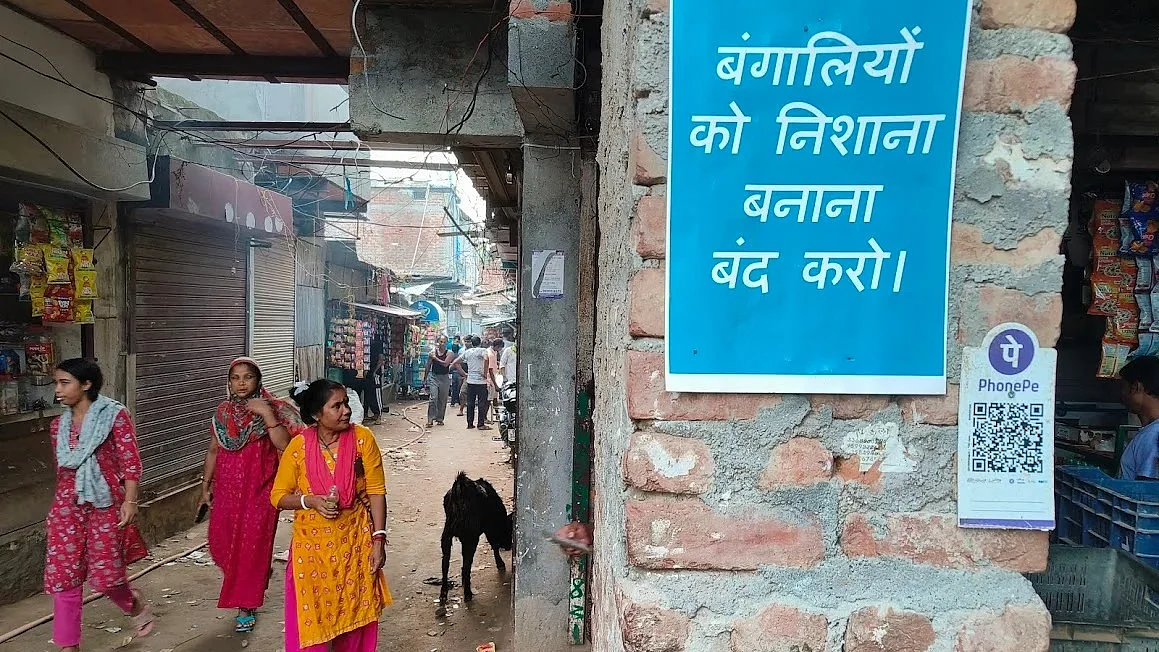
The Caste Dynamic in Persecution of Bengali Muslims That No One's Talking About
The Opposition failed to name these attacks on Bengali migrant workers for what it is—an attack on the OBCs.

advertisement
In recent weeks, two issues have severely impacted the Muslim community of West Bengal.
The Supreme Court on 28 July had put a stay on the Calcutta High Court order that nullified the new Other Backward Classes (OBC) list notified by the West Bengal government. The Bharatiya Janata Party (BJP) had earlier accused the Mamata Banerjee government of "appeasing the Muslims" by including many backward Muslim castes in the new list.
The other issue that has become the political hot potato in the state are the attacks on Bengali migrant workers in the BJP-ruled states of Haryana, Gujarat, Maharashtra, Odisha, and Chhattisgarh.
Though these two issues appear in no way connected to each other, I would argue otherwise—and say that caste remains an important factor in deciding who would belong to which district of West Bengal and become migrant workers.
Caste among Bengali Muslims
According to the Mandal Commission report (page 59), the criteria to include non-Hindu OBCs are:
All untouchables converted to any non-Hindu religion
Occupational communities known by the name of their traditional hereditary occupation and whose Hindu counterparts have been included in the list of Hindu OBCs (like Dhobi, Tell, Theemar, Nai, Gujar, Kumhar, Lohar, Darji, and Badhal)
At the bottom of the social ladder, we have the Arzal Muslims who do the scavenging, sweeping, and other forms of unclean jobs—and they fulfil the first criterion of the Mandal Commission. Ajlafs are the innumerable occupational groups like weavers, oil pressers, tailors, and a large number of peasant classes who deserve the OBC status per the second criteria of the commission.
Following the Mandal Commission, the Jyoti Basu government in 1993 prepared a list of OBCs in West Bengal and included eight Muslims castes like Jolaha, Fakir/Sain, Dhunia, and Nasya Sekh.
In its aftermath, Buddhadeb Bhattacharya as chief minister in the last days of the Communist rule in 2010 announced 41 more Muslim castes like Sardar, Nikari, Shershahbadia, and Khottas as the OBCs.
When Mamata Banerjee came to power in the state, she had continued with this subcategorisation. Her government further amended the reservation rules and included 35 more Muslim caste groups like Hajjam, Sardar, Beldar, Laskar, Jamadar, Rajmistri, Mali, Penchi, and Molla in the new OBC list. In this way, the government announced that reservation covers almost 90 percent of the Muslims in the state and addresses their socioeconomic concerns.
The Trinamool Congress government challenged this in the SC and announced a fresh caste-based benchmark survey in March this year to identify backward castes. In June, following the survey, the government announced a new OBC list with 142 groups and retained almost all but two previously cancelled Muslim castes. As the Calcutta High Court had put a stay even on this new list, the latest SC order now allows the government to resume pending recruitments and admissions in colleges and universities with OBC reservations.
Bengali Muslim Migrant Workers and Caste
In recent years, OBC reservation policy has allowed students from these backward Muslim castes better representation in jobs, medical colleges and universities in the state.
Most of the time, the state had done surveys to identify backward caste groups only for the above purposes. In the absence of caste enumeration, or other administrative surveys, we lack data on the caste question in the number of migrant workers. According to the state government, over 22 lakh of migrant workers work outside the state.
The Quint in its stories of Bengali migrant workers evacuating their shanties in Gurugram due to fear of custodial torture as suspected Bangladeshi, had highlighted their jobs as waste pickers, sanitation workers, and car cleaners.
The action against Bengali Muslims has crippled the garbage collection and domestic work in upscale localities of Gurugram. It can be said almost certainly that these Muslims driven out of Gurugram and other parts of the country belong to the OBC groups notified by the state.
In the past, in April 2022, when the North Delhi Municipal Corporation razed alleged encroachments in Jahangirpuri following cases of communal violence, it targeted the shops and homes of Khotta Muslims from Bengal who were working as ragpickers in the area. Whenever media reports emerge on manhole deaths of sanitation workers in Gurugram and Delhi, along with the names of Dalit Hindus, we often find Bengali Muslims in the deceased list from Malda or both Dinajpur districts of West Bengal. The occupation of these migrant workers clearly gives us some hint on the caste location of these workers.
Mamata Banerjee and her party MPs have raised their voice against these attacks on Bengali workers from the lens of language pride and regional identity. No doubt that the religion and language of these Bengali Muslims make them prime targets as suspected Bangladeshi, but it is wrong to ignore their caste location.
Leader of Opposition in the Lok Sabha and Congress MP Rahul Gandhi has been busy organising many OBC conferences with representation of many backward castes from different states. However, his politics of OBC has ignored the realities of West Bengal, a state where the Congresss had six MPs and LoP status in the state Assembly not long back.
All these Opposition politicians failed to name these attacks on Bengali migrant workers for what it is—an attack on the OBCs.
(Adil Hossain is a faculty at the School of Development, Azim Premji University. He can be reached at @adilhossain. This is an opinion piece and the views expressed are the author’s own. The Quint neither endorses nor is responsible for the same.)
- Access to all paywalled content on site
- Ad-free experience across The Quint
- Early previews of our Special Projects
Published: undefined